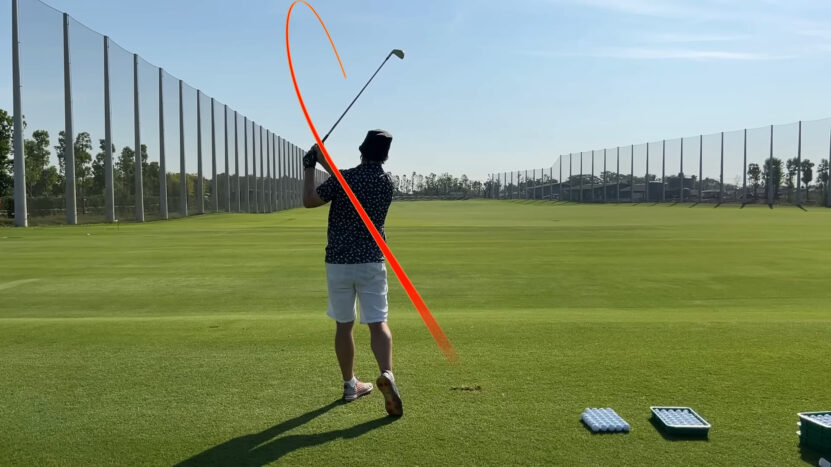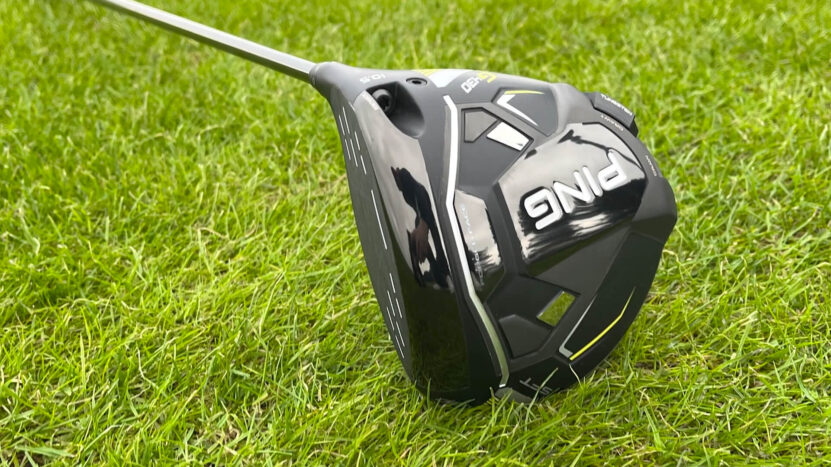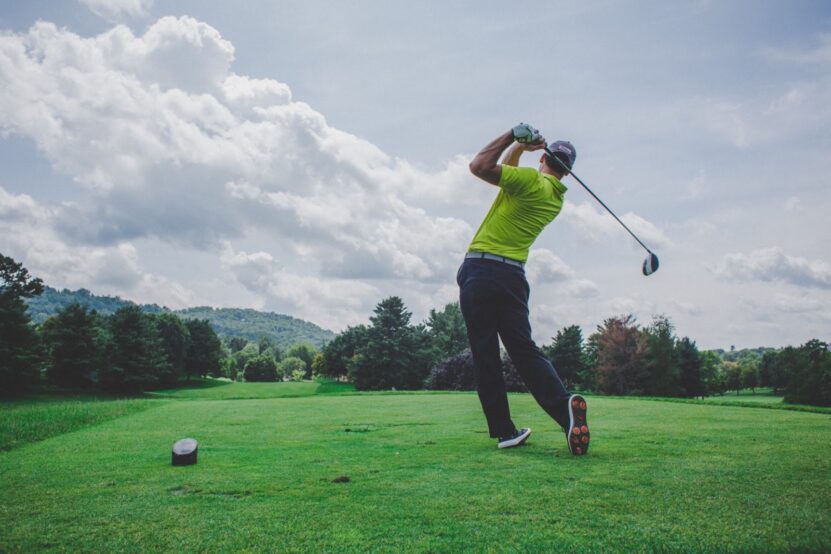Golfers everywhere know that mastering shot shapes is essential to improving their game. Learning how to hit a fade can be a powerful addition to your arsenal, helping you find more fairways and become a more consistent player.
This guide will break down everything you need to know about hitting a fade, including setup, swing techniques, and how to use equipment to your advantage.
Key Takeaways
- Setup: Open stance, ball forward in stance, and neutral grip.
- Swing Path: Focus on an outside-in path with an open clubface at impact.
- Equipment: Ensure neutral or fade bias on your clubs and experiment with tee height.
What Is a Fade in Golf?
A fade is a controlled shot in golf that moves from left to right (for right-handed golfers) or right to left (for left-handed golfers).
Unlike a slice, which is often unintentional and uncontrollable, it is precise and can help you deal with obstacles like trees, bunkers, and doglegs.
Many professional golfers favor it because of its accuracy and predictability, despite sacrificing a few yards of distance.
How it Can Improve Your Game?
- Accuracy: By controlling the ball flight, you reduce the risk of missing the fairway.
- Versatility: Dealing with obstacles, such as bunkers, hazards, or trees.
- Consistency: It’s often easier for amateur golfers to control a fade than a draw, making it a great shot to develop for more consistent rounds.
Setup for Hitting
The correct setup can drastically improve your chances of hitting a successful shot.
Open Stance
Align your body slightly to the left of the target. This open stance will encourage an outside-in swing path, which is crucial for creating the left-to-right ball movement.
Ball Position
Place the ball slightly forward in your stance. Moving the ball forward helps ensure you strike it at the right moment in your swing, with the clubface slightly open to create the fade.
Grip
Professional golfers like Dustin Johnson have a strong grip but still manage to hit powerful fades. Adjust your grip so your hands are neutral or slightly rotated to the right (for right-handed golfers), which will help keep the clubface open at impact.
Swing Techniques
1. Outside-In Swing Path
The most critical element in hitting a fade is an outside-in swing path. Start your downswing by bringing the clubhead slightly outside the target line and then swinging inward through impact. This path will generate the left-to-right spin needed for a fade.
2. Open Clubface at Impact
Make sure the clubface is slightly open at impact. An open clubface is what causes the ball to spin and curve from left to right.
3. Maintain Smooth Tempo
Rushing your swing can lead to inconsistency. Focus on making a smooth, controlled swing. This will help maintain balance and ensure the correct clubface position at impact.
4. Visualizing
Visualizing your shot is crucial for success. Pick a target slightly left of where you want the ball to finish. Commit to the shot and trust your setup and swing mechanics.
Here’s an interesting analysis of Jessica Korda’s swing.
Common Mistakes
Even with proper setup and swing techniques, mistakes can happen.
- Closed Stance: If your stance is too closed, you’ll end up promoting a draw or a hook. Ensure your stance is open to the target.
- Gripping Too Tightly: A tight grip can prevent the clubface from opening at impact, leading to a straight shot or even a draw.
- Over-Swinging: Trying to muscle the ball can lead to inconsistent results. Focus on a smooth, controlled swing instead.
Drills to Practice

| Tee Height | Ball Flight | Backspin |
|---|---|---|
| Standard (Half Ball Above Clubhead) | Balanced flight | Moderate backspin |
| Lower (Quarter Ball Above Clubhead) | Lower flight | Increased backspin |
| Higher (Three-Quarters Above Clubhead) | Higher flight | Reduced backspin |
Alignment Drill
Place alignment sticks or clubs on the ground to ensure your stance and clubface are correctly aligned for a fade. Position one stick parallel to your target line and another pointing slightly left to indicate your stance.
Cone Drill
Set up cones or tees in a straight line, slightly to the left of your target. Practice hitting shots that start left of the cones and curve back toward the target. This drill will help you develop the outside-in swing path necessary for a fade.
Tee Height Drill
Experiment with different tee heights to find what works best for your fade. A lower tee can help reduce backspin and promote a more controlled shot, while a higher tee can give you a higher launch angle.
How Equipment Affects Your Ability to Hit a Fade?

The right equipment can make hitting a fade much easier.
Neutral Club Settings
Many drivers and woods come with adjustable settings. If your club is set to a draw bias, hitting it will be much more difficult. Make sure your clubs are set to neutral or fade bias to increase your chances of hitting a fade consistently.
Clubface Loft
Using a club with more loft, like a 3-wood or 5-wood, can make it easier to hit a fade. The added loft helps create a higher launch angle and promotes the left-to-right ball flight of a fade.
Advanced Shots
A power fade combines the controlled ball flight with the distance of a draw. To hit a power fade, you need to adjust a few elements of your setup and swing.
- Stronger Grip: A slightly stronger grip will help generate more power while still allowing the clubface to remain open at impact.
- More Aggressive Swing: While you still want to maintain control, swinging slightly more aggressively can add distance to your fade without sacrificing accuracy.
- Higher Tee Height: Raising the tee slightly can help you achieve a higher launch angle and longer carry distance.
Professional Golfers Who Rely on It
Many of the world’s top golfers rely on a fade to win tournaments.
- Dustin Johnson: Known for his long, powerful drives, Johnson uses a fade as his primary shot off the tee. He credits his success to the consistency and control a fade provides.
- Jack Nicklaus: One of the greatest golfers of all time, Nicklaus often favored a fade because of its accuracy and predictability, especially under pressure.
FAQs
Do You Lose Distance with a Fade?
While hitting a fade usually sacrifices a few yards compared to a draw, the added control and consistency often make up for the slight loss in distance. Players like Dustin Johnson have made fades their go-to shot despite being known for their power off the tee.
Should You Always Hit a Fade?
Not necessarily. Some holes require a draw, while others are better suited for a fade. Understanding how to hit both shots can make you a more versatile golfer. However, a fade can be more consistent and forgiving for many players, especially off the tee.
Can You Hit a Fade with Irons?
Yes, hitting a fade with irons follows the same principles as with a driver or wood. Adjust your stance, swing path, and clubface to produce the fade. Irons can help you control the height and spin of the shot, which is useful for approaching greens.
Last Words
Hitting a fade is all about taking control. Get your stance open, swing outside-in, and keep that clubface slightly open. Practice until it’s automatic. With enough work, you’ll start owning the course, hitting fairways, and shaving strokes off your score. Keep grinding, and that fade will become your secret weapon.

